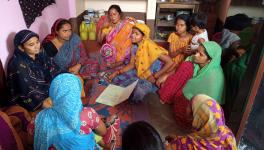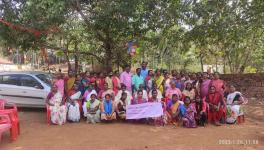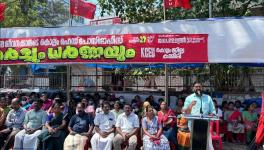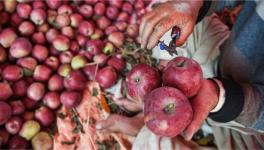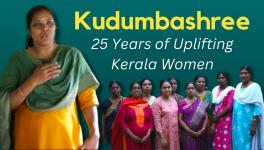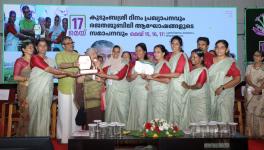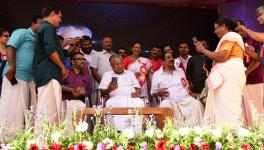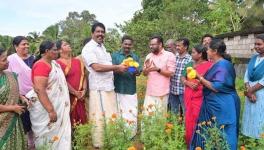How Kerala’s Cooperative Model is Making Strides Despite Odds
Image Courtesy : Kerala Government
In May 2019, Prime Minister Narendra Modi led the Right wing Bharatiya Janata Party (BJP) to a spectacular victory in the national elections. An absolute majority in his second five-year term will cement his two-pronged agenda of Hindu majoritarianism and neoliberal economic reform, which aim to erode India’s diverse socio-cultural fabric and federal policy-making structures.
True to form, he immediately asked top bureaucrats in key ministries to fast-track, within 100 days, structural reforms in agriculture, infrastructure, transport, labour and industry to boost private investment.
On July 8, 2019, the agriculture ministry invited state agriculture ministers to New Delhi to garner support for various agriculture schemes promoted by the central government. Some 12 ministers attended the meeting, in which contract farming was pushed as a solution for low exports and productivity in the beleaguered sector.
There was a lone discordant voice, that of Sunil Kumar, the agriculture minister from Kerala. Kumar, who represents the state’s Left Democratic Front (LDF) government, asserted that rather than contract farming by agribusiness corporations, his state would prefer to promote collective farming by cooperatives and community networks.
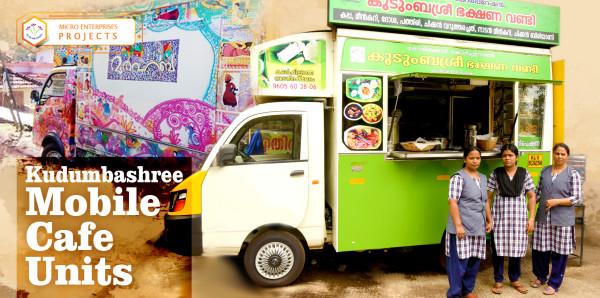
Image Courtesy: Benny Kuruvilla
Kumar’s was not an empty rhetoric. Kerala has one of India’s most vibrant network of cooperatives. Its ministry of cooperation lists 11,892 cooperative societies that function across sectors, such as agriculture, dairy, industry and services—including banks, hospitals, colleges, grocery stores and restaurants. Kerala has less than 3% of India’s population, yet accounts for 17% of cooperative membership.
What explains the predominance of worker-owned cooperatives in Kerala even as India lurches to the Right, with rising inequality and the ascendancy of big business in virtually all spheres of economic activity?
Left Agenda of Deepening Democracy
Kerala has a history of organised radical labour, older than its formation as a state in 1956. In its first state election in 1957, Kerala chose a communist party-led government. Ever since, the LDF has held power alternatively with the Congress-led United Democratic Front.
Despite being out of power quite regularly, the organisational strength of Left parties, trade unions and people’s movements have ensured the continuity of cooperatives, social schemes and labour rights. This is an exceptional feature of Kerala compared with the rest of India.
Cooperatives in Kerala have benefited from progressive measures undertaken by Left-wing governments, such as providing adequate budgetary allocations and strengthening governance, training and research.
Kumar draws his confidence on the feasibility of collective farming from a two-decade old programme for women’s empowerment, called Kudumbashree, which means “prosperity of the family” in Malayalam. This programme was initiated by the LDF government in 1998 as part of its ambitious state-wide programme called the people’s plan campaign for democratic decentralisation.
Today, the Kudumbashree mission unites over 4.3 million women in what has been described as one of the ‘greatest gender justice and poverty reduction programs in the world’. It is open to one adult woman from every household in Kerala and is primarily organised around neighborhood collectives that comprise women who are economically disadvantaged.
As of March 2019, there were 2,91,507 such neighborhood collectives across Kerala. With an incredible coverage of nearly 60% of all Kerala households, it has spawned a diverse network of collectives spread across sectors, such as textiles, construction, transport, restaurants, handicraft, agro-processing and farming. Added to low interest loans and subsidies, these collectives are also provided access to technology, training and marketing from the mission office and district resource teams.
The women collectives of farmers of Kudumbashree are perhaps its most innovative and inspiring feature. Some 320,000 women are organised into 59,478 agricultural collectives and farm up to 43,375 hectares in 14 districts.
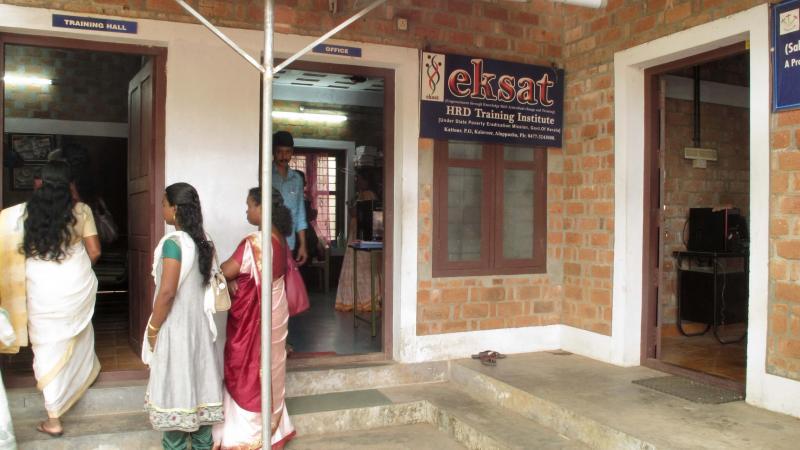
Image Courtesy: Benny Kuruvilla
This programme is unique on several counts. First, women enter the programme as cultivators, not labourers. A group of four to 10 women form what is called a Joint Liability Group (JLG), which then identifies land for cultivation in the village and surrounding areas. The JLG is then supported by Kudumbashree and the panchayat (local government) in various ways — from registering the land lease, facilitating subsidised loans, provision of farm machinery, subsidised seeds, fertilisers and pesticides. The state agriculture department also provides periodic training and technical support.
The collective members always work on the farm themselves or, if the farm is larger, can hire outside labour. The agriculture produce is first consumed by families of the collective members and the remaining surplus is sold in the village markets.
Collective farming has been one of the biggest successes of Kudumbashree, with thousands of hectares of otherwise fallow land being brought under cultivation for rice, vegetables and fruits. Recently, the Food and Agriculture Organization High Level Panel of Experts of the Committee on World Food Security commended the contribution of Kudumbashree to livelihood security and as a tool of political awareness in Kerala. In the 2015 local body elections in Kerala, 13,993 members from various Kudumbashree collectives contested and 7,376 women won with an impressive strike rate of 52%.
As India continues to be in the throes of a deep agrarian crisis, an estimated 2,040 quit farming every day. Kudumbashree has bucked this trend and brought tens of thousands of the poorest women back to agriculture, enhancing their food and livelihood security and revitalising production in Kerala. An estimated 10,000 women are now designated as expert “master farmers” and help the mission as resource persons and to train volunteers.
These women are now part of the Kudumbashree National Resource Organisation and are helping other states such as Odisha, Jharkhand, Assam, Bihar and Karnataka to replicate the programme. In 2015, officials from South Africa and Ethiopia also discussed collaboration with the Kerala government.
Forging Worker-Peasant Alliances
The Brahmagiri Development Society (BDS), a social alliance of peasants and workers, was initiated in response to the agrarian crisis in the northern hill district of Wayanad. With a crash in prices in the region’s main crops such as pepper, coffee and cardamom due to trade liberalisation, farmers were caught in a debt trap. This resulted in several hundred peasant suicides over half a decade. In a meeting convened by panchayats in the district that was also attended by representatives of Left peasant groups, several proposals were tabled, including the importance of diversification of the regional economy by setting up a network of cooperatives.
Since 2000, BDS has implemented a range of programmes in collaboration with local panchayats, such as watershed development, biogas plants, milk cooperatives, farmers’ markets, agro-chemical products and training workshops for farmers.
The latest BDS project is Malabar Meat, which was launched in 2014. This is a modern meat processing plant set up at a five-hectare campus in the town of Sulthan Bathery. It is India’s largest multispecies abattoir and the country’s first farmer-worker cooperative in the meat industry with both forward and backward linkages with the local economy.
Currently, 13,500 members from neighbouring villages are part of various BDS initiatives. Malabar Meat provides buffalo calves, goats and baby chickens at subsidised rates to roughly 2,500 of them. These cattle breeding programmes are partly undertaken in collaboration with the Kudumbashree mission and funded by the state-run National Bank for Agriculture and Rural Development. When the animals and chicken attain maturity for slaughter, the cooperative buys them back at guaranteed market rates, enabling its farmer-members to make a profit.
The mechanised slaughter and processing unit provides direct employment to 130 people who are mostly from the local community. Some 16 products, including frozen meat, cutlets and sausages from the unit are sold at competitive rates through a network of more than 105 Malabar Meat outlets across the region.
Of the total project cost of Rs 20 crore ($2.8 million), the Kerala government provided Rs 4 crore ($571, 000) as a grant and Rs 10 crore ($1.4 million) as a low interest loan. More funds were raised through member contributions and local people. In February 2017, Malabar Meat received a financial assistance of Rs 10 crore from the Kerala government for capital investment and for increasing the distribution of calves to farmers under the cooperatives buy-back scheme. Plans are also underway to set up Malabar Meat outlets across the state and enable online delivery.
Other examples include the iconic Kerala Dinesh, set up in 1969 as a worker-owned beedi cooperative. Kerala Dinesh was the result of a spirited struggle by workers for decent wages and work conditions. At its peak in the 1970s, its membership rose to 42,000.
Today, as beedi use wanes due to changing trends and health concerns, the cooperative has changed track and diversified into other sectors such as agro-processing, textiles, software and umbrella manufacturing. All of these enterprises continue to be worker-owned and run. The annual turnover of Kerala Dinesh in 2018 was Rs 60 crore ($850,000).
New Challenges
But Kerala’s cooperatives face many challenges as they have to continuously reinvent and diversify in a fast-changing and adverse national and international economic context. New policies introduced by the Modi government such as the 2017 Goods and Services Tax have curtailed Kerala’s ability to raise resources for social schemes, essential services and development projects.
In response, the LDF government is planning to launch the Kerala Cooperative Bank (KCB) which will merge 15 district cooperative banks and their branches. With 820 branches, the KCB will be India’s largest cooperative bank. It will fund development activities in the state and provide loans specifically to farmers, women and small business enterprises.
Another challenge is the rising power of technology corporations and their evident and future disruptions in the world of work and consumption. The continued attempt by central governments for deeper trade and investment integration through free trade agreements will further increase the imports of cheaper agricultural and industrial products.
As Kerala’s cooperatives gear up to face complex and formidable challenges, they continue to offer inspiring examples of an alternative future where solidarity enterprises put workers and societal welfare before profit.
Benny Kuruvilla heads the India office of Focus on the Global South, an activist think-tank in Asia providing analysis and building alternatives for just, social economic and political change. This article is an abridged version of a paper from the book Public Finance for the Future we want.
Get the latest reports & analysis with people's perspective on Protests, movements & deep analytical videos, discussions of the current affairs in your Telegram app. Subscribe to NewsClick's Telegram channel & get Real-Time updates on stories, as they get published on our website.









